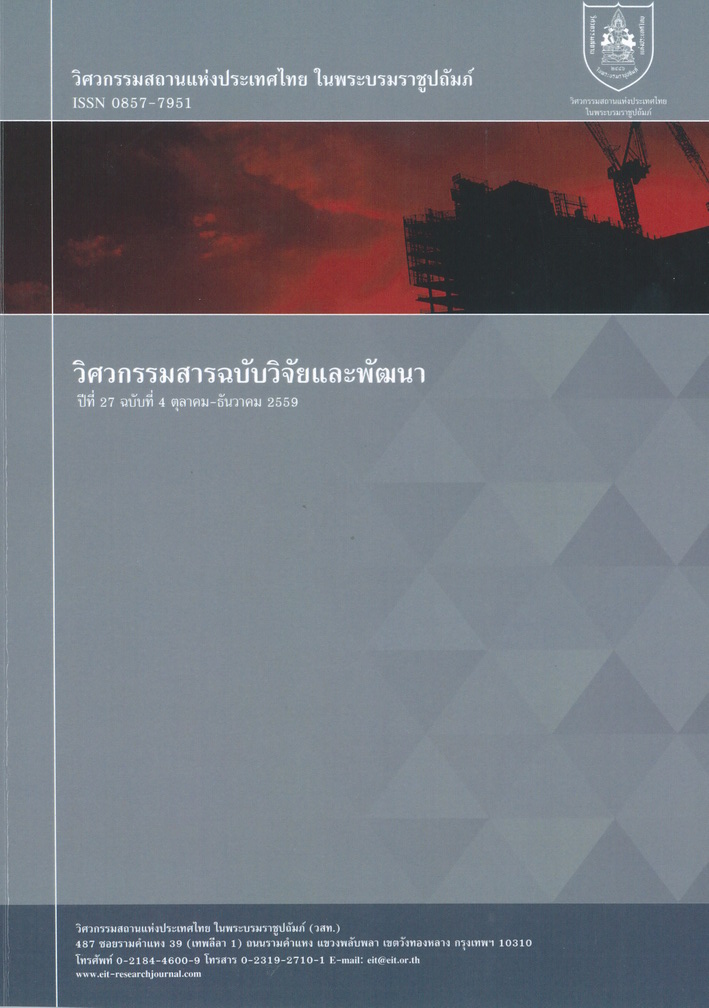ANALYSIS OF FORCE IN TENSION STRUCTURES OF BANGKOK ARENA STADIUM ROOF
Main Article Content
Abstract
งานวิจัยนี้นำเสนอผลการประเมินค่าแรงในโครงสร้างรับแรงดึงของหลังคาสนามบางกอกอารีนาด้วยแบบจำลองโครงสร้าง 3 มิติ โดยค่าแรงในโครงสร้างรับแรงดึงได้จากการคำนวณด้วยความถี่ธรรมชาติที่ได้จากการตรวจวัดระหว่างการก่อสร้าง และนำข้อมูลค่าแรงดึงที่ได้จากการตรวจวัดในขั้นต่างๆ ถึงขั้นตอนสุดท้ายมาสร้างแบบจำลองด้วยโปรแกรมวิเคราะห์โครงสร้าง ผลการศึกษาพบ ว่า ความแตกต่างสูงสุดระหว่างค่าแรงดึงที่วิเคราะห์ได้จากแบบจำลองโครงสร้างและจากการตรวจวัดในแต่ละเส้นมีค่าประมาณ 9% แต่ผลรวมแรงดึงของทุกเส้นในแต่ละขั้นตอนมีความแตกต่างกันเพียงเล็กน้อยไม่เกิน 2% และเมื่อนำแบบจำลองโครงสร้างนี้ไป วิเคราะห์ในกรณีการเพิ่มน้ำหนักบรรทุกจร และกรณีการเพิ่มแรงกดของแรงลมกระทำกับแบบจำลองโครงสร้างจะส่งผลให้ค่าแรง ดึงของโครงสร้างรับแรงดึงในแต่ละเส้นมีค่าแรงดึงเพิ่มขึ้นจากขั้นตอนสุดท้ายไม่เกิน 2% และ 3% ตามลำดับ และสำหรับกรณีการ เพิ่มแรงยกของแรงลมกระทำกบั แบบจำลองโครงสร้างจะส่งผลให้ค่าแรงดึงในแต่ละเส้นมีค่าลดลงจากขั้นตอนสุดท้ายไม่เกิน 7% ซึ่งสามารถนำแบบจำลองโครงสร้าง 3 มิตินี้ไปใช้สำหรับการทำนายพฤติกรรมด้านการรับน้ำหนักของโครงสร้างรับแรงดึงในกรณี เนื่องจากแรงอื่นๆ ได้ต่อไป
This paper presents analysis results of force in tension structures of Bangkok Arena Stadium roof using three-dimensional structural models. The tension in cable was determined from the measurement of natural frequencies during the construction. The identified forces from several stages of construction were used to calibrate the model for analysis. It was found that the maximum difference between the tension in a single cable from analysis and measurement was about 9% and the difference of the summation of tension in all investigated cables was about 2%. The study also examined on the additional effects of live load, wind pressure and wind suction by analyzing the structural model with the final tension. The increment of tension in each member was about 2% and 3% due to live load and wind pressure, respectively. It was also observed that the decrement of tension in each member was about 7% or less due to wind suction. Finally, this 3D structural model can be used for examination of load-carrying behavior of the structure from other load cases.
Article Details
The published articles are copyright of the Engineering Journal of Research and Development, The Engineering Institute of Thailand Under H.M. The King's Patronage (EIT).


